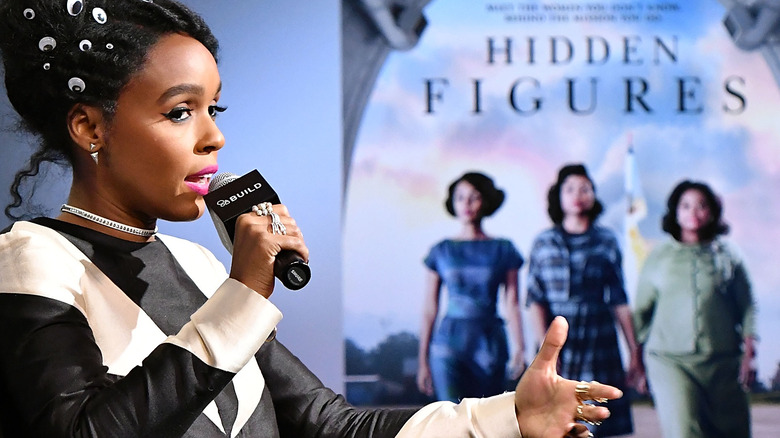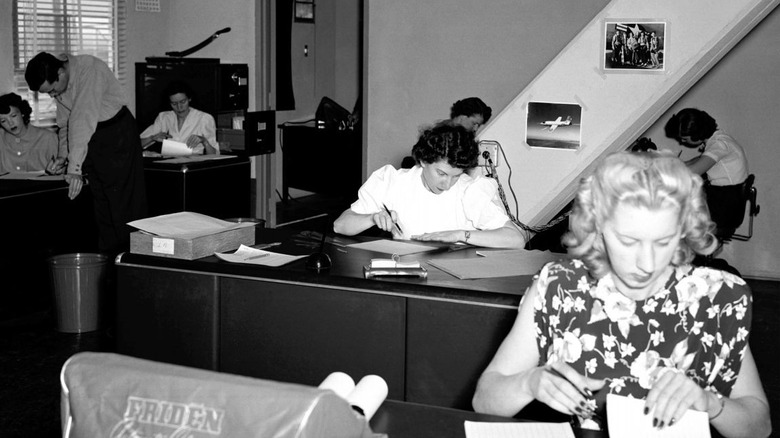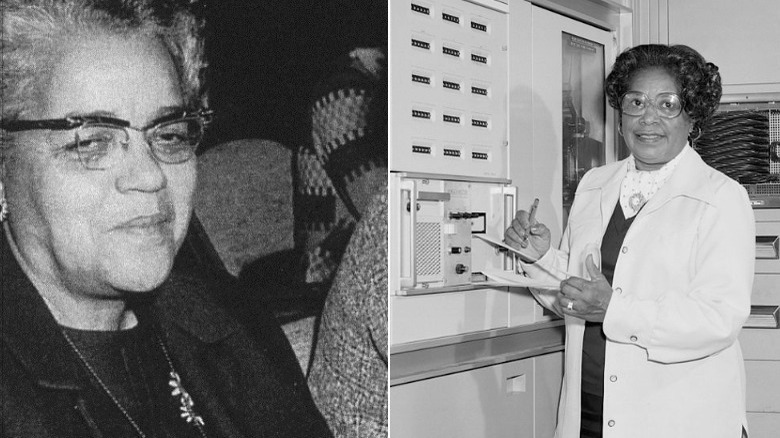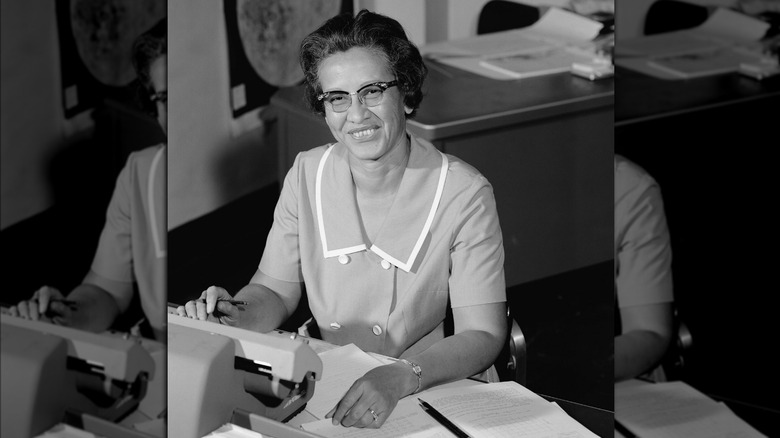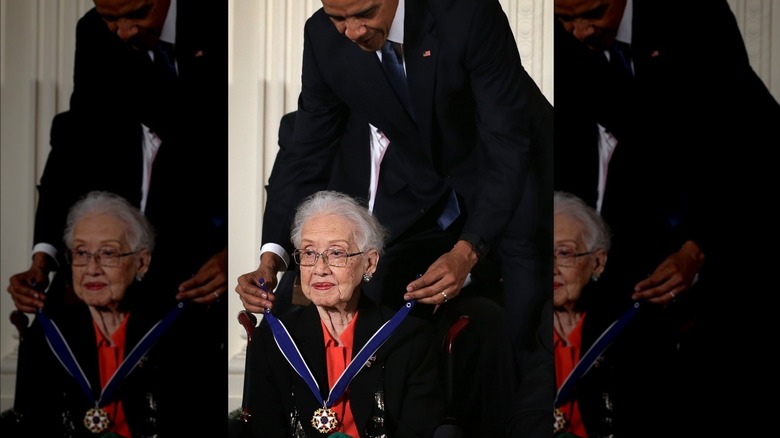The True Story That Inspired Hidden Figures
When the film "Hidden Figures" came out in 2016, it left many viewers shocked. Typically, when we're told about America's early space program, the story revolves around the white men astronauts who went into space and the white men engineers who got them there. Instead, "Hidden Figures" centralizes the Black women mathematicians who helped make the space program possible — women who, up until that point, had largely been ignored.
Per Smithsonian Magazine, "Hidden Figures" — which stars Taraji P. Henson, Janelle Monáe, and Octavia Spencer — was based on a book of the same name, written by Margot Lee Shetterly. Shetterly grew up just a few miles from NASA's Langley Research Center, which is where "Hidden Figures" takes place. Inspired by the stories she heard as a child, Shetterly spent several years pouring through old newspaper clippings, telephone directories, archival records, and interviews to piece together the history of Langley's Black women employees. Ultimately, Shetterly found that the behind-the-scenes calculations performed by these women were integral to NASA's early successes, and she documents their work and the struggles they faced in her book.
While 2016's film adaptation had to omit many details from Shetterly's research, "Hidden Figures" provides a valuable overview of what life was like for NASA's Black women "computers," focusing on the lives of three women in particular.
Women 'computers' were the backbone of aeronautical research
In the late 19th and early 20th centuries, before the word "computer" referred to a programmable machine, a "computer" was a person. Specifically, computers were the people, typically women, who performed lengthy calculations by hand in order to advance the work of higher-ranking scientists and engineers. Per Popular Mechanics, one of the earliest instances of human computers was at the Harvard College Observatory. In the late 1800s, Harvard employed a team of women to analyze stellar data collected by the university's astronomers.
Likewise, NACA — the National Advisory Committee for Aeronautics, which would later evolve into NASA — hired its first women computers in 1935. These NACA computers helped analyze flight data. Initially, they were all white. But during World War II, following an anti-discrimination order passed by President Franklin Roosevelt, NACA began hiring Black women computers as well. Yet, as Popular Mechanics explains, NACA was a segregated workplace. Black women had to use separate dining facilities and bathrooms, and were paid less than their white counterparts. Because they were originally segregated to the western section of NACA's Langley campus, these Black mathematicians became known as the "West Computers."
Over NACA/NASA's history, there were hundreds of West Computers. But, as "Hidden Figures" author Margot Lee Shetterly told Space.com, "You can't make a movie with 300 characters. It is simply not possible." Instead, "Hidden Figures" focuses on three of these groundbreaking women.
Dorothy Vaughan and Mary Jackson did critical math for NASA
The first of the core trio in "Hidden Figures" is Dorothy Vaughan (above, left) portrayed by Octavia Spencer. Per Space.com, the real Dorothy Vaughan was born in 1910, and began work for NACA in 1943, where she worked with the West Computers. In 1949, Vaughan became NACA's first black supervisor. Vaughan stayed at NACA/NASA for several decades, where she taught herself and her coworkers the programming language FORTRAN, and contributed to numerous rocket launches. Vaughan died in 2008 at the age of 98.
The next key person is Mary Jackson (above, right), portrayed in the film by Janelle Monáe. Space.com reports that Jackson was born in Hampton, Virginia in 1921. After getting a job with NACA's West Computers in 1951, Jackson's work centered around analyzing the data from flight tests.
Per Popular Mechanics, Jackson moved from being a "computer" to assisting one of NASA's aeronautical engineers, who encouraged Jackson to become an engineer herself. In order for that to happen, though, Jackson had to take extra graduate classes at night, as the film depicted, despite already having a dual degree in math and physical science. Another roadblock: The high school that hosted the night classes was segregated, so Jackson had to petition the city government to be able to attend the classes. Jackson succeeded, and in 1958, she became NASA's first Black, female engineer. Jackson died in 2005 at the age of 83.
Katherine Johnson's orbital calculations aided the early space program
The central protagonist in "Hidden Figures" is Katherine Johnson, portrayed by Taraji P. Henson. The real Katherine Johnson (above) was born in the small town of White Sulphur Springs, West Virginia, in 1918. And, as the movie implies, Johnson was quite a mathematical prodigy. Per West Virginia University, Johnson graduated from high school at the age of 14 and college at 18, with a joint degree (summa cum laude!) in mathematics and French.
After spending some years as a school teacher and raising three daughters, Johnson joined NACA's West Computers in 1953, per Space.com. Like Mary Jackson, Johnson's early work focused on analyzing flight test data. But Johnson was later recruited to do the work for which she is best remembered: performing trajectory calculations for America's manned space program.
Johnson assisted with the trajectory calculations for Alan Shepard's mission in 1961, helping the United States send its first human into space, though the film focuses on Johnson's work helping John Glenn's mission in 1962. The math behind this later mission was a great deal more complicated. While Shepard simply went up into space and back down like a bullet, Glenn's mission was designed to make him the first American to actually orbit the Earth.
Johnson helped send the first Americans into space — and, later, to the Moon
Many of the orbital calculations for John Glenn's mission were performed by computers — actual, mechanical computers, not NACA's women computers. But in an era when computers were still a relatively new technology, NASA wanted to be sure that the numbers were right, so Johnson was responsible for double-checking the computers' trajectory calculations. As "Hidden Figures" correctly shows, Johnson was personally asked to re-crunch the numbers by Glenn himself. Per Popular Mechanics, quoting from the book that inspired the film, Glenn reportedly asked NASA's engineers to "Get the girl to check the numbers ... If she says the numbers are good ... I'm ready to go."
Johnson did check the numbers, and Glenn's mission was successful in part due to her dedicated work. Johnson stayed at NASA for many years after that, and went on to perform trajectory calculations for the Apollo missions, including 1969's historic Moon landing.
Space.com reports that Johnson retired from NASA in 1986. In 2015, President Barack Obama awarded Johnson the Presidential Medal of Freedom — America's highest civilian honor. Johnson lived to see herself portrayed on the silver screen in 2016's "Hidden Figures." That same year, NASA named a new computational facility at Langley Research Center in her honor. At the naming ceremony, NASA writes, Johnson professed that all her contributions were "just another day's work." Johnson died in 2020 at the age of 101.
